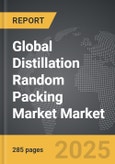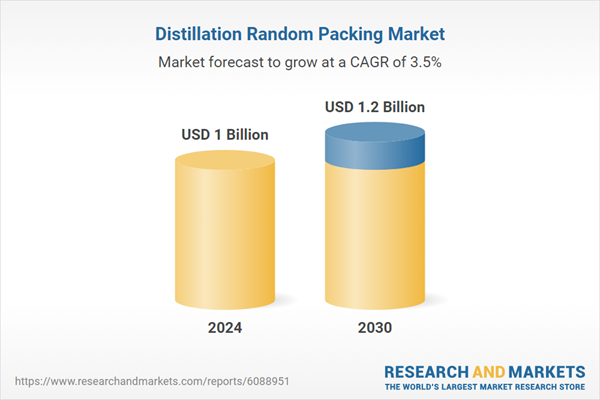Global Distillation Random Packing Market - Key Trends & Drivers Summarized
Why Is Distillation Random Packing Still Vital in Today's Separation Technologies?
Distillation random packing remains a core component of mass transfer operations in chemical processing, petroleum refining, environmental management, and pharmaceutical manufacturing. Designed to enhance the surface area for vapor-liquid contact within distillation columns, random packings such as Raschig rings, Pall rings, and Berl saddles provide critical support in facilitating efficient separation of fluid mixtures. Unlike structured packing, which is ordered and uniform, random packing consists of loose fill materials that are poured into columns and offer excellent adaptability, ease of installation, and cost-effectiveness. These attributes make random packing particularly useful in retrofitting old towers or applications that experience frequent throughput changes. Industries rely on these components to reduce pressure drop, improve mass transfer efficiency, and support high-capacity operations under both atmospheric and vacuum conditions. With growing demand for purified chemicals, solvents, and fuels, particularly in Asia-Pacific and the Middle East, the use of random packing is expanding as companies aim to maximize yield, reduce energy consumption, and maintain flexibility in their process designs. Moreover, random packing is preferred in corrosive or fouling environments where the risk of blockage and coking is high, due to its open structure and lower cost of replacement. Its role in optimizing unit operations for energy conservation and throughput enhancement continues to make it a vital asset in global separation processes.How Are Material and Design Innovations Elevating the Efficiency of Random Packing?
Material science and geometric innovation have significantly transformed the performance capabilities of distillation random packing in recent years. Traditionally made from ceramic or metal, random packings are now increasingly manufactured using high-performance plastics like polypropylene, PVDF, and PTFE, which offer improved chemical resistance, lower weight, and higher operational flexibility. These modern materials enable use in highly corrosive environments, such as acid recovery or chlorination towers, where metal or ceramic would degrade over time. In addition to material upgrades, the shape and surface texture of random packing elements have evolved to enhance contact efficiency and fluid distribution. Newer designs, such as super-intalox saddles and cascade mini-rings, are engineered to reduce pressure drop and increase mass transfer by improving surface wetting and minimizing liquid holdup. Computational fluid dynamics (CFD) modeling is also being used to simulate vapor-liquid interaction and optimize the design of new packing geometries, leading to higher theoretical plate numbers and better separation performance per unit volume. Manufacturers are further developing hybrid packings that combine the benefits of random and structured configurations to serve applications demanding both flexibility and high throughput. These innovations are making random packing more competitive with structured packing, especially in cost-sensitive or complex applications where adaptability and process robustness are key considerations.Why Does the Global Demand for Random Packing Vary Across Industries and Regions?
The global demand for distillation random packing is influenced by industrial sector priorities, energy strategies, and infrastructure maturity across different regions. In North America and Western Europe, where the chemical and petrochemical industries are well-established, random packing is predominantly used in refinery operations, solvent recovery systems, and environmental scrubbing towers. These markets focus on upgrading legacy systems and improving operational efficiency with minimal capital investment, making retrofitting with advanced random packing an attractive option. In contrast, the Asia-Pacific region - led by China, India, and Southeast Asia - is witnessing rapid capacity expansion in chemical manufacturing, specialty chemicals, and agrochemicals, driving new installations that heavily rely on cost-effective and scalable separation solutions. The Middle East is also emerging as a key growth hub, particularly in gas processing and petroleum refining, where demand for high-performance random packing is bolstered by large-scale capital projects and increasing downstream diversification. Meanwhile, Latin America and Africa are slowly catching up, driven by industrialization and environmental mandates that require efficient separation and scrubbing systems. Industry-wise, pharmaceuticals and food processing require high-purity operations and have begun adopting plastic and specialty random packing materials for hygienic distillation needs. The environmental sector also contributes significantly to demand, particularly in wastewater treatment and air pollution control systems that rely on gas absorption and stripping processes. These regional and sector-specific variations highlight the need for customized solutions, technical support, and strategic distribution networks to serve diverse and evolving markets effectively.What Are the Key Drivers Fueling Growth in the Distillation Random Packing Market?
The growth in the distillation random packing market is driven by a combination of industrial process optimization, environmental compliance, and increasing demand for resource efficiency. A major growth catalyst is the expanding global chemical and petrochemical industry, which relies heavily on thermal separation techniques to purify raw materials and intermediate products. As production scales up and raw material inputs become more diverse, industries are under pressure to optimize distillation column performance - an area where high-efficiency random packing can deliver substantial improvements in throughput and energy use. Environmental regulations are another significant driver, particularly those aimed at reducing emissions, VOCs, and wastewater contaminants. Random packing is widely used in scrubbing systems and solvent recovery units that help plants meet compliance targets while minimizing operational costs. The rise in renewable energy and bio-based chemical production has also opened new avenues for random packing, especially in processes like ethanol distillation, CO2 capture, and biodiesel purification. Furthermore, the demand for modular, easily maintainable, and low-footprint process solutions in remote or decentralized facilities adds to the appeal of random packing over more complex alternatives. On the technical front, the increasing use of simulation software, automation, and process analytics is allowing engineers to design more efficient columns tailored to specific packing characteristics. The combined influence of regulatory, economic, and technological trends ensures that random packing remains a preferred choice for many separation applications, fueling its steady growth in the global process industry landscape.Report Scope
The report analyzes the Distillation Random Packing market, presented in terms of market value (US$). The analysis covers the key segments and geographic regions outlined below:- Segments: Type (Metal Packing, Plastic Packing, Ceramic Packing); Application (Petrochemical, Fine Chemical, Food & Beverages, Pharmaceuticals, Water Treatment, Environment & Emissions, Other Applications).
- Geographic Regions/Countries: World; United States; Canada; Japan; China; Europe (France; Germany; Italy; United Kingdom; Spain; Russia; and Rest of Europe); Asia-Pacific (Australia; India; South Korea; and Rest of Asia-Pacific); Latin America (Argentina; Brazil; Mexico; and Rest of Latin America); Middle East (Iran; Israel; Saudi Arabia; United Arab Emirates; and Rest of Middle East); and Africa.
Key Insights:
- Market Growth: Understand the significant growth trajectory of the Metal Packing segment, which is expected to reach US$755.4 Million by 2030 with a CAGR of a 3.8%. The Plastic Packing segment is also set to grow at 2.6% CAGR over the analysis period.
- Regional Analysis: Gain insights into the U.S. market, valued at $273 Million in 2024, and China, forecasted to grow at an impressive 6.5% CAGR to reach $246.1 Million by 2030. Discover growth trends in other key regions, including Japan, Canada, Germany, and the Asia-Pacific.
Why You Should Buy This Report:
- Detailed Market Analysis: Access a thorough analysis of the Global Distillation Random Packing Market, covering all major geographic regions and market segments.
- Competitive Insights: Get an overview of the competitive landscape, including the market presence of major players across different geographies.
- Future Trends and Drivers: Understand the key trends and drivers shaping the future of the Global Distillation Random Packing Market.
- Actionable Insights: Benefit from actionable insights that can help you identify new revenue opportunities and make strategic business decisions.
Key Questions Answered:
- How is the Global Distillation Random Packing Market expected to evolve by 2030?
- What are the main drivers and restraints affecting the market?
- Which market segments will grow the most over the forecast period?
- How will market shares for different regions and segments change by 2030?
- Who are the leading players in the market, and what are their prospects?
Report Features:
- Comprehensive Market Data: Independent analysis of annual sales and market forecasts in US$ Million from 2024 to 2030.
- In-Depth Regional Analysis: Detailed insights into key markets, including the U.S., China, Japan, Canada, Europe, Asia-Pacific, Latin America, Middle East, and Africa.
- Company Profiles: Coverage of players such as 3M Company, Ahlstrom-Munksjö, Ansell Limited, C.P. Nonwoven Products Co., Ltd., Cardinal Health and more.
- Complimentary Updates: Receive free report updates for one year to keep you informed of the latest market developments.
Some of the 36 companies featured in this Distillation Random Packing market report include:
- Alfa Chemistry
- AMACS
- Ambani Metals
- Exlabesa
- HAT International
- Knight Material Technologies
- Koch Knight LLC
- Koch-Glitsch
- MACH Engineering
- Mantec Technical Ceramics
- Mass Transfer Limited
- MTE Group
- ProPack Dichtungen Und Packungen AG
- Raschig GmbH
- Rvt Process Equipment, Inc.
- SP-Teploobmen
- Stanford Advanced Materials
- Sulzer Chemtech
- Sumitomo Heavy Industries
- Varun Engineering
This edition integrates the latest global trade and economic shifts into comprehensive market analysis. Key updates include:
- Tariff and Trade Impact: Insights into global tariff negotiations across 180+ countries, with analysis of supply chain turbulence, sourcing disruptions, and geographic realignment. Special focus on 2025 as a pivotal year for trade tensions, including updated perspectives on the Trump-era tariffs.
- Adjusted Forecasts and Analytics: Revised global and regional market forecasts through 2030, incorporating tariff effects, economic uncertainty, and structural changes in globalization. Includes historical analysis from 2015 to 2023.
- Strategic Market Dynamics: Evaluation of revised market prospects, regional outlooks, and key economic indicators such as population and urbanization trends.
- Innovation & Technology Trends: Latest developments in product and process innovation, emerging technologies, and key industry drivers shaping the competitive landscape.
- Competitive Intelligence: Updated global market share estimates for 2025, competitive positioning of major players (Strong/Active/Niche/Trivial), and refined focus on leading global brands and core players.
- Expert Insight & Commentary: Strategic analysis from economists, trade experts, and domain specialists to contextualize market shifts and identify emerging opportunities.
Table of Contents
Companies Mentioned (Partial List)
A selection of companies mentioned in this report includes, but is not limited to:
- Alfa Chemistry
- AMACS
- Ambani Metals
- Exlabesa
- HAT International
- Knight Material Technologies
- Koch Knight LLC
- Koch-Glitsch
- MACH Engineering
- Mantec Technical Ceramics
- Mass Transfer Limited
- MTE Group
- ProPack Dichtungen Und Packungen AG
- Raschig GmbH
- Rvt Process Equipment, Inc.
- SP-Teploobmen
- Stanford Advanced Materials
- Sulzer Chemtech
- Sumitomo Heavy Industries
- Varun Engineering
Table Information
| Report Attribute | Details |
|---|---|
| No. of Pages | 285 |
| Published | December 2025 |
| Forecast Period | 2024 - 2030 |
| Estimated Market Value ( USD | $ 1 Billion |
| Forecasted Market Value ( USD | $ 1.2 Billion |
| Compound Annual Growth Rate | 3.5% |
| Regions Covered | Global |









